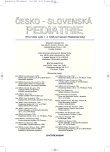-
Medical journals
- Career
Phenylketonuria in Adulthood
Authors: D. Procházková 1; P. Konečná 1; L. Kolbová 1; E. Hrabincová 2; H. Vinohradská 3; H. Hrstková 1
Authors‘ workplace: 1. dětská interní klinika LF MU a FN Brno přednostka prof. MUDr. H. Hrstková, CSc. 1; Centrum molekulární biologie a genové terapie IHOK FN Brno přednosta prof. MUDr. J. Vorlíček, CSc. 2; Oddělení klinické biochemie FN Brno primář doc. MUDr. M. Dastych, CSc. 3
Published in: Čes-slov Pediat 2008; 63 (11): 601-605.
Category: Original Papers
Overview
One hundred adult patients with phenylketonuria (PKU) and hyperphenylalaninemia (HPA) aged from 18 to 43 years were examined. 55% of patients with PKU were not on a low-protein diet. 45% of them kept the diet but 22.2 % had the phenylalanine blood level higher than 20 mg/dl.
The educational attainment of patients:
66.2% of patients were apprenticed, 21.7% of them finished their secondary school, 1.2% finished college and 1.2% finished university studies. 6% of patients attended special-needs school and 3.6 % of them were unable to educate.
The body mass index (BMI) of female patients was 23.6 ± 0.05 (16.8–43.6). BMI of male patients was 24.0 ± 0.8 (16.7–38.9). The 7.4 % of female patients and 13.0 % of male patients had the BMI >30.
In the case of interruption or extenuation of the diet eleven patients (from 18 to 38 years old patients, 8 women and 3 men) restarted a low-protein diet because of following problems: body wasting, angst, breathlessness, anxious disorder and insomnia requiring psychiatric medication, activity disorder, migraine. One female patient was treated for mycosis fungoides. The most frequently observed mutations were p.R408W (41.7 % of patients), p.R158Q (16.7%) and p. R261Q (8.3%).Key words:
PKU, adulthood, education, BMI, low-protein diet
Sources
1. Kozák L, Blažková M, Kuhrová V, et al. Mutation and haplotype analysis of phenylalanine hydroxylase alleles in classical PKU patients from the Czech Republic: identification of four novel mutations. J. Med. Genet. 1997;34 : 893–898.
2. Čechák P, Hejcmanová L, Procházková D, et al. Výsledky screeningu hyperfenylalaninémií v českých zemích v letech 1970–2000. Čes.-slov. Pediat. 2001;56 : 667–670.
3. Zeman J, Bayer M, Stepan J. Bone mineral density in patients with phenylketonuria. Acta Pediatr. 1999;88 : 1348–1351.
4. Koch R, Buton B, Hoganson G, et al. Phenylketonuria in adulthood: a collaborative study. J. Inherited Metab. Dis. 2002;25 : 333–346.
5. Antshel KM, Waisbren SE. Developmental timing of exposure to elevated levels of phenylalanine is associated with ADHD symptom expression. J. Abnorm. Child Psychol. 2003;31 : 565–574.
6. Hyanek J, Kozak L, Hrabincova E, et al. Maternal hyperphenylalaninemias in healthy Czech population of pregnant women: 30 years experience with screening, prevention and treatment. Bratisl. lek. Listy 2004;105 : 291–298.
7. Procházková D, Konečná P, Kozák L, et al. Maternální fenylketonurie (PKU) v regionu Moravy. Čes.-slov. Pediat. 2005;60 : 251–256.
8. Walter JH, White FJ. Blood phenylalanine control in adolescents with phenylketonuria. Int. J. Adolesc. Med. Health 2004;16 : 41–45.
9. Gassio R, Campistol J, Vilaseca MA, et al. Do adult patients with phenylketonuria improve their quality of life after introduction/resumption of a phenylalanine-restricted diet? Acta Pediatr. 2003;92 : 1474–1478.
10. Ürge O, Strnová J, Mosendzová B. Fenylketonúria adolescentov a dospelých na Slovensku. Čes.-slov. Pediat. 2003;58 : 423–425.
11. Griffiths PV, Demelweek C, Fay N, et al. Wechsler subscale IQ and subtest profile in early treated phenylketonuria. Arch. Dis. Child. 2000;82 : 209–215.
12. Bosch AM, Tybout W, van Spronsen FJ, et al. The course of life and quality of life of early and continuosly treated Dutch patients with phenylketonuria. J. Inherit. Metab. Dis. 2007;30 : 29–34.
13. Wagenknecht M, Gauner V, Kunešová M, et al. Vztahy mezi faktory ,,Dotazníku jídelních zvyklostí“, socioekonomickým stavem a zdravotními riziky u české populace. Čas. Lék. čes. 2007;146 : 284–291.
14. Moseley R, Koch R, Moser AB. Lipid status and long-chain polysaturated fatty acid concentrations in adults and adolescents with phenylketonuria on phenylalanine restricted diet. J. Inherit. Metab. Dis. 2002;25 : 56–64.
15. Muntau AC, Röschinger W, Habich M, et al. Tetrahydrobiopterin as an alternative treatment for mild phenylketonuria. N. Engl. J. Med. 2002;26 : 2122–2132.
16. Miller HE, Weglage J, Bick U, et al. Brain imaging and proton magnetic resonance spectroscopy in patients with phenylketonuria. Pediatrics 2003;112 : 1580–1583.
17. Weglage J, Wiedermann D, Denecke J, et al. Individual blood-brain barier phenylalanine transport in siblings with clasiccal phenylketonuria. J. Inherit. Metab. Dis. 2002;25 : 431–436.
18. Burgard P, Rupp A, Konecki DS, et al. Phenylalaninhydroxylase genotypes, predicted residua enzyme activity and phenotypic parameters of diagnosis and treatment of phenylketonuria. Eur. J. Pediatr. 1996;155(Suppl 1): 11–15.
19. Scriver ChR. The PAH gene, phenylketonuria, and a paradigma shift. Human Mutation 2007;28 : 831 – 845.
Labels
Neonatology Paediatrics General practitioner for children and adolescents
Article was published inCzech-Slovak Pediatrics

2008 Issue 11-
All articles in this issue
- Phenylketonuria in Adulthood
- Pitfalls of Prenatal Ultrasound Screening in Diagnostics of Serious Inborn Developmental Defects of the Kidney and Urinary Pathways
- Choledochal Cyst – Clinical Manifestations, Surgical Technique and Results
- Case Report of Injury in Rectum-Sigmoid Region in a Fifteen-Year Boy
- Preimplantation Genetic Diagnostics of Monogenic-based Diseases: Possibilities, Pitfalls and First Accomplishments in the Czech Republic
- Psoriasis in Children – is there anything new?
- Therapy of Bronchial Asthma, Atopic Eczema, Diseases of the Kidney and Urinary Pathways at the Children Spa Hospital, the Kynžvart Spa
- Czech-Slovak Pediatrics
- Journal archive
- Current issue
- Online only
- About the journal
Most read in this issue- Phenylketonuria in Adulthood
- Choledochal Cyst – Clinical Manifestations, Surgical Technique and Results
- Pitfalls of Prenatal Ultrasound Screening in Diagnostics of Serious Inborn Developmental Defects of the Kidney and Urinary Pathways
- Case Report of Injury in Rectum-Sigmoid Region in a Fifteen-Year Boy
Login#ADS_BOTTOM_SCRIPTS#Forgotten passwordEnter the email address that you registered with. We will send you instructions on how to set a new password.
- Career

